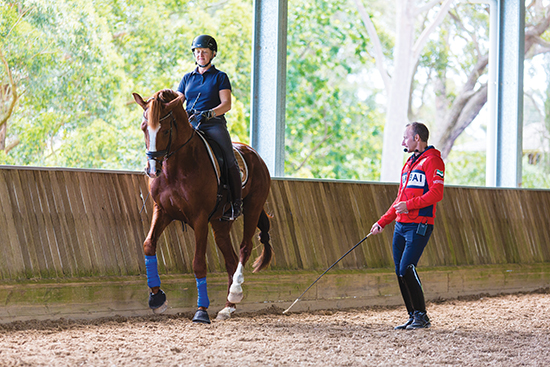 The American dressage trainer is not afraid to speak his mind – as you will find in this interview with Rebecca Ashton…
The American dressage trainer is not afraid to speak his mind – as you will find in this interview with Rebecca Ashton…
Jeremy Steinberg is a great clinician.
“Who is Jeremy Steinberg?” I hear you say. In the past he’s been the coach of the United States Youth Team and been New Zealand’s High Performance Coach. He is a brilliant communicator, carrier of the flame for the old dressage masters, and has some powerful insights into what is good, and what is bad in modern competition dressage.
So why haven’t you heard of him?
Travelling the globe to conduct close to 50 clinics a year leaves him less time than he’d like to campaign a horse for international representation. Also, the American is not prepared to change his whole life for a sport that he depressingly admits might be heading in the wrong direction. Happy to say what he really thinks, the young clinician is fresh, thought-provoking, incredibly knowledgeable and confronting. He’s worth listening to.
I caught up with Jeremy on a recent visit to Australia where he was conducting clinics at Heidi Scott’s lovely little property in Glenorie on the outskirts of Sydney.
How did dressage start for you?
“I grew up in Seattle Washington riding with a guy called Dietrich von Hopffgarten. I knew at the time that he was good but I didn’t realise until later in life just how good he was. He really knew what he was talking about and I probably shouldn’t have argued with him as much as I did!”
“Dietrich’s wife Kim Beardsley von Hopffgarten was a brilliant rider who rode for the US in the 1982 World Championships on a Thoroughbred, Woodmix. She was probably about 5’10’’, willowy, soft, elegant and just beautiful. It was the first time I had really seen anyone look like that on a horse. Her horses were light, soft and pleasant. It was a whole different level of riding and I was blown away. I was 15 at the time and I didn’t even think it was the same riding that everyone else was doing.”
“No one in the States at the time had a barn of Grand Prix horses like Dietrich did, so I thought I’ve got to go and ride with him. I wanted a job because I couldn’t afford lessons. He looked at me and said, “I don’t hire men. Men don’t take orders from women well and I don’t want men riding my horses because they’re too tough.” His wife and her sister ran the barn because he was always away on weekends. Eventually he offered that, in return for lessons, I could mow the lawn around the barn, dig some ditches and do “man’s work” but I couldn’t work in the barn.”
“Dietrich had grown up in Germany and his mother was a prolific horse woman who was involved with the Trakehner Verband. They were in Prussia and she was on the flight across country to the West that took the two groups of horses away from the invading Russians who were going to eat them all. He was a bratty kid and so his mother took him to Von Neindorff’s and kind of left him there when he was about 17 or 18. Egon von Neindorff raised him and was his biggest influence.”
“I think he really wanted to get out of Germany eventually because of the memories of the war that had taken his father.”
“I started working with him late 80s, early 90s and I stayed with him until he passed away in 2005. I got a little bit of help from others but I never thought anyone was as good as Dietrich with the development of the horses. I did get some help from Klaus Balkenhol when he was the team coach. He’s such a great, positive person to have in your corner. He’s a real confidence builder.”
“When Dietrich passed away I was really lost trying to find someone to help me – I still struggle with that now to a point. I’m not a fan of a lot of the changes in the riding and I’m pretty outspoken about it.”
How do we get dressage ‘back on track’ do you think?
“Honestly, I don’t think you can. Perhaps I’m too cynical or jaded but it’s become this big machine with so many moving parts and I don’t think you can change it. I think it’s unfortunate because so much of what I look at and think is correct, is being traded out for flashy. It’s not that flashy in itself is bad. A big, flash moving horse can be correct and classical, but I look at some horses such as Totilas and see the way it moves has certain underlying faults that people are so willing to overlook and ignore instead of it being an ongoing discussion. Sure this one is by far the best one around, but these things still aren’t the ideal. We idolise them to the point that everybody looks at everything they do as perfect, and they strive for that with their own horses.”
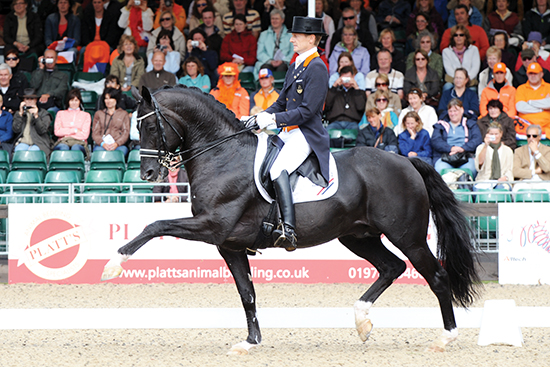
“I think it’s unfortunate that so much of what I look at and think is correct, is being traded out for flashy. It’s not that flashy in itself is bad. A big, flash moving horse can be correct and classical, but I look at some horses such as Totilas and see the way it moves has certain underlying faults that people are so willing to overlook and ignore instead of it being an ongoing discussion…”
“Back to Totilas, I looked at the horse and I watched him work in person quite a few times. It was magical: the piaffe, passage, how rideable he was, the calm of the horse’s eye was beautiful under Edward Gal. There was never a time you looked at that horse and thought it was abused or stressed. It really was special and amazing to see, but there were things that were wrong, like the flying changes could be short behind, the trot extensions weren’t right, with the hind leg never matching the front leg. If you said that, you’d always get this combative response, whether from the masses or the judges – “You don’t sit in the judges box and you don’t have judging training.” Can’t we at least agree that certain things should get 9s or 10s, and recognize Totilas it is one of the most amazing horses we’ve ever seen, but admit that everything was not perfect?”
“Valegro is in the same boat. It’s not anything against Carl or Charlotte because Carl must be doing something right to keep all these Grand Prix horses rolling out, and to teach a rider to ride successfully at that level. But if you look at Valegro and take note of some of the things he does; that’s a very odd rhythm and tempo in the pirouettes, he’s a little out behind in the passage sometimes, the frame doesn’t always compute to me exactly right. Do I still think it’s the best horse in the world? Without a doubt. But we do have to be careful about idolising.”
“If you look at Valegro and take note of some of the things he does; that’s a very odd rhythm and tempo in the pirouettes, he’s a little out behind in the passage sometimes, the frame doesn’t always compute to me exactly right. Do I still think it’s the best horse in the world? Without a doubt. But we do have to be
careful about idolising…”
“I also think the judging is not standardised. For example, Anky started this trend years ago on Bonfire where the flash and the mechanics are more important than the mental calm and relaxation. You could really compare horses like Gigolo and Bonfire; you had one which was really awkward and weird but had a strange looseness, suppleness, elasticity and calm to it. Then you had Bonfire who was mechanically just banging things out and was way more frantic in the way it worked. You looked at them and though they were both the best in the world, there was always the discussion if you were Team Bonfire or Team Gigolo.”
“But I respected how technically good Anky was and again the way she could produce these horses and keep them sound. Salinero, 19 years old and looking better than ever, where there’s us Americans saying our horse is 15 and we’re retiring it because it could never get better than this. What a bunch of hog wash. Ahlerich, Rembrandt, Salinero, Bonfire, Gigolo. I look at all these horses and they kept going and the riders kept them sound.”
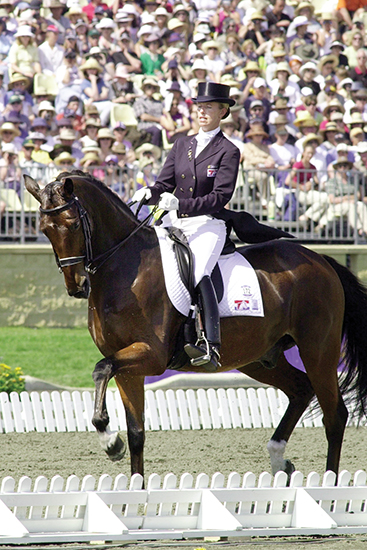
“Anky started this trend years ago on Bonfire where the flash and the mechanics are more important than the mental calm and relaxation. You could really compare horses like Gigolo and Bonfire; you had one which was really awkward and weird, but had a strange looseness, suppleness, elasticity and calm to it. Then you had Bonfire who was mechanically just banging things out and was way more frantic in the way it worked…”
“Anky started this new Dutch training system that it’s okay that the horses work under this tension and it created this situation of a lot of people reproducing a similar thing and on the other side, a lot of people saying ‘no we don’t ride like that’. This derisive schism has developed, and not just two sides but three, four, five sides. They just keep branching off. You see the judges and the trends and the riders and the trainers, every time there’s a new top horse it becomes the new system and the new way of riding instead of sticking to basic principles of what’s right and what’s wrong.”
“Parzival was always a real pet peeve of mine. I’ve never met Adelinde personally but I’ve heard stories that she’s a pretty cool person. She’s a smart, sharp, educated girl. I’ve just liked everything I’ve read about her and I think, god there’s this kid who is so brilliant and I see the riding and the coaching she’s getting and it’s two completely different things. She is a product of this system that Anky created in Holland that it is an okay way of riding that the horses get brutalised into submission. Adelinde got that horse to Grand Prix, and more power to her, because the thing was an arsehole and broke her arm. The judges were scoring her high because that’s what they were accustomed to seeing, and decided it was okay. It’s top of the world and in some ways it was more correct than Totilas, which is why there was this, ‘Which one is going to win?’ and will it be another Bonfire versus Gigolo “Clash of the Titans” situation.”
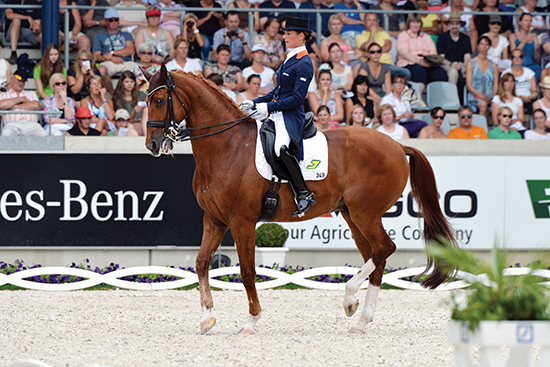
“Adelinde is a product of this system that Anky created in Holland, that this is an okay way of riding, and it’s okay that the horses get brutalised into submission. Adelinde got that horse to Grand Prix and more power to her because the thing was an arsehole and broke her arm. The judges were scoring her high because that’s what they were accustomed to seeing and had decided it was okay…”
“This type of riding culminates at the Olympics and all of a sudden Valegro comes in, and again it has its own little things that are wrong, and Parzival comes in with little things and tensions, but both are on top of the world. Then you put these two horses together and the judges make a decision. I like Stephen (Clarke) but I thought that what he said after the final Olympic tests was a real problem. All of a sudden, he says the judges were all in unanimous agreement, and the scores reflected it, Parzival couldn’t win because the tension was too high, and Valegro was so much looser and softer. So when the horses were finally compared to each other, you couldn’t ignore that fact that Parzival went with this tension, but the sad fact was that Parzival went with that tension its whole career and it went unnoticed or at least unspoken. If you spoke about it you got bashed because you’re not allowed to have an opinion that differs from the general masses.”
“All of a sudden Stephen Clarke and the judges have agreed that Parzival is not this score anymore; he’s not a Valegro, which wouldn’t have happened if there was no Valegro. Parzival would have won, he would have still been on top and everybody, instead of wanting Charlotte for clinics which they all do now, would have wanted Adelinde the way they wanted Anky and Nicole Uphoff back in the 80s.”
“So, Adelinde almost gets pushed aside just on this one comment, and ever since the Olympics, the horse has never competed with good results. The problem is, you take this really smart girl and you say to her, ‘All of a sudden, we have decided the tension of your horse will not score anymore. The rules haven’t changed but having judged him to a certain standard all these years we have decided to judge him at a different standard because there is a Valegro and we’re not going to hold you to a certain level of judging we’ve held you accountable for. We are now going to hold you accountable for things we previously ignored.’”
“Being a smart person, she goes out and finds a different trainer to change the way she rides and it has fallen apart. It’s so sad to see this system has raised someone like Adelinde, a sharp girl who was probably getting bad advice or exposed to bad judging, to produce this horse which was relative to what was being scored, the top of the world and in one day, one horse show, her whole life is shattered now because the judges changed their mind on how they’re going to score something because they’ve seen another horse they like more, instead of owning a standard and holding everybody accountable to the same standard.”
“The rules are pretty clear about the way the horse sits, the lift of the front hoof and the cannon bone relative to the hind hoof and the fetlock in the piaffe anyway and the way the tempo works in the canter pirouette versus the rhythm. It’s right there in the rule book. There’s all these things that just seemed to quietly go unnoticed.”
“So when you ask can we change it, I look at how that trend goes and I think there’s no way. The masses are so strong. I know a lot of people keep trying but they get burnt out and they get shot down. For me I get, ‘Well you don’t show at that level.’ I don’t want to show at that level. I watch it, I know everyone, maybe one day when my horse is there and things work out. I like my life how it is and if it can work into my life I’ll do it but I don’t want to change my life to compete because I could be the next Adelinde. I could be riding to a standard and getting scored, and the next day the judges change their mind. I know the judges get upset when you criticise or say something, but somewhere along the line there has to be more discussion and on their end more open mindedness to listen to criticism because they end up dictating the sport.”
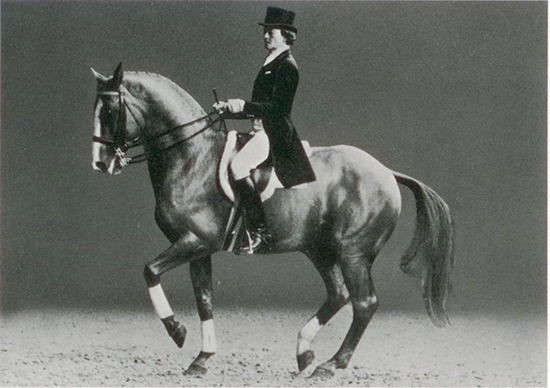
“The rules are pretty clear about the way the horse sits, the lift of the front hoof and the cannon bone relative to the hind hoof and the fetlock in the piaffe anyway, and the way the tempo works in the canter pirouette versus the rhythm. It’s right there in the rule book. There’s all these things that just seemed to quietly go unnoticed.”
“You can still like one horse over another but if you can’t tell me what’s wrong with the horse as well, then your opinion is not one I can validate or respect. There has to be room for further growth in that way.”
I’ve heard you talk about the art of dressage versus it as sport? How do we judge both? Via the freestyle?
“I love freestyle. I don’t think it necessarily takes away from the technical side of things. Tests don’t necessarily need to be this repeated pattern over and over. If the judges can’t see that the horse swings in the tempi changes on the diagonal, maybe our judges need better training. The only exception to that could perhaps be the collected walk or a lateral walk. You can get very clever doing it on a curved line, not on a straight line or doing it away from a judge. There are little things like that but the overall quality, you’re going to see. You could even write rules that state your collected walk has to be on a short side. I do like the idea of compulsory patterns and you could make freestyle rules where certain patterns have to be shown sequentially like in figure skating.”
Does the sport belong in the Olympics?
“No. I feel like dressage has out-lived its welcome in the Olympics, which is sad. They’re talking about the need to get more nations in and make it more open for everybody, and we have to show more fairness. I think they’re living a pipe dream because developing nations cannot get involved unless they spend millions of dollars. So it’s not like this amateur-friendly sport that we’re talking about opening up to more nations. What they’re really asking is – can more rich people come and play with us? In a developing nation, trying to get an athlete in, you really still need to have funding that puts them in a different category to the general population of the country.”
“I’m not hoping it leaves the Olympics, and I don’t think you can fully buy your way into the Olympics. You do somewhere have to ride a bit, but you don’t have to be the best rider in your country to represent your country, but if you do represent your country, you’re considered one of the best riders in your country.”
“I equate it a little bit to running and Usain Bolt, who’s the fastest man on earth right now, no questions asked. Put Nikes on him, put tennis shoes on him, make him run barefoot, he’s probably going to run faster than you, and pretty much everyone else. He is an athlete. It’s him and him alone. He could have been raised in Poland, in the Philippines, anywhere, but if he runs like that, he’s going to go to the Olympics and he’s going to win the gold medal.”
“What if we had a pair of shoes that we could buy that could make you run almost as fast as him, maybe not quite as fast, but right up there and it made you the fastest person in your country? You had to be a runner, but you didn’t have to be the best runner, and you could buy the shoes and the shoes were really expensive, and most normal people couldn’t afford them. Everyone was out there with shoe makers trying to make more of them, or breed more of them. You get to go the Olympics and maybe you come third or fifth but you get to come home and say, ‘I was fifth at the Olympics and I got to compete with Usain Bolt. I’m that level of an athlete.’”
“Meanwhile, if I take your shoes off and put you and Joe Schmo in a normal pair of Nikes and Joe Schmo blows you out of the water, but Joe can’t afford those expensive shoes. You’re not the better athlete. So when I look at the horse sports like this at the Olympics, I think it isn’t really fair anymore. It’s always been a bit like this, but it is getting worse.”
“It wasn’t when it was military based. The trend started to change in the 80s, but even then it was still relatively fair. People were going with off the track Thoroughbreds. I know it can still happen, like Valegro, but that’s not the norm. Now the quality of the horses is so high that you can have a lot of money and be competing with Charlotte, saying I’m almost as good because I’m competing against her. But you’re not. The medals should go to the horses. Riders shouldn’t be able to take them home and say they’re an Olympic athlete. The horse is the athlete. The rider’s the steerer!”
“It’s not an athlete competing against the best athletes, it’s the wealthiest competing against each other. A lot of times I look at our country and we’re not alone, the Germans are terrible about it……it’s like everything’s for sale as soon as the Olympics are over. I mean they don’t all get sold, but they put a price tag on them. One of our horses left for Denmark, so that Danish rider now has a nice, trained horse. I get it, but it’s not a fair sport when she paid how many millions, and is now competing trying to get a slot from another Danish rider who is a better rider. I’m pretty frustrated with the Olympics!”
Any standout issues in the clinics you teach here?
“No. I don’t see anything nationalistic about how the horses go here. You and the New Zealanders are so far removed in this part of the world that I don’t think you realise quite how good some of the riders and horses are, relative to the rest of the world. I mean there’s bad riding everywhere in the world, but I’ve been pleasantly surprised by some of the standard of riding. When I see someone like Brett Parbery ride I think, ‘That guy can sit’. He’s a beautiful rider. He would stand out in Europe just in terms of a quality rider just sitting on a horse riding around, not doing anything magic. That horse he has at Grand Prix, it’s not a bad horse, but it’s very normal horse and the fact that he gets out of it what he does says something about the quality of riding. That’s not an average rider who can do that. That really impressed me.”
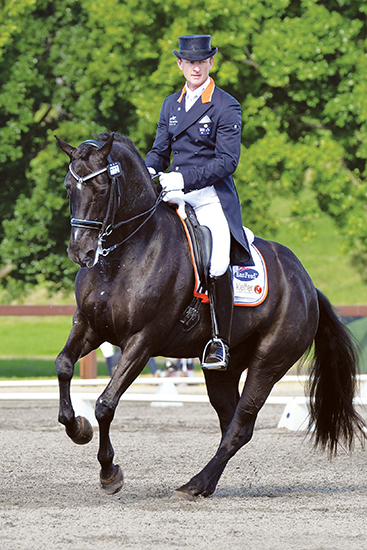
“When I see someone like Brett Parbery ride I think, ‘That guy can sit’. He’s a beautiful rider. He would stand out in Europe just in terms of a quality rider just sitting on a horse riding around, not doing anything magic. That horse he has at Grand Prix, it’s not a bad horse, but it’s very normal horse and the fact that he gets out of it what he does says something about the quality of riding. That’s not an average rider who can do that. That really impressed me…”
When you teach, do you tend to start with the horse or the rider?
“I go back and forth. Like I had one rider yesterday who said they wanted to work on their position. I was happy to put them on a lunge line and take their stirrups away, but the horse was kind of a jerk. We needed to sort some of that out before I could put them in that situation, not because he would hurt the rider, but because it would send the horse’s training so far back. The rider wasn’t doing anything right and that was hindering the horse, but temperamentally the horse needed attention.”
“There was another one today who wanted to work on some of the energy of the trot and instead I just adjusted the rider’s body, took her stirrups away, got her more upright, got her legs further back, and got her in a really good dressage posture, which most people tend to ignore. By the end of the lesson, the horse had all the power it needed, was hotter, was more up in front, just by adjusting the rider’s body.”
Do you read a lot of dressage books?
“I teach a lot of theory. There are two types of dressage that we really deal with. There’s applicable, real world dressage and there’s theoretical dressage. I take offence at people who don’t have a strong theoretical dressage background because I think it’s not skin of your teeth, shoot in the dark. You’re dealing with an emotional being that you could potentially traumatise. You could take this living being and ruin it for life if you do the wrong things at the wrong time. Whereas if you have this real theoretical approach, even within your ‘real world’ work, you’re trying to keep pure to this theoretical thought.”
“I’ve read almost every dressage book that I’ve been able to get a hold of, but I find less and less nowadays. They seem to be more autobiographies and fluff and pictures about ‘how great my training program is’. Like Johann Hinnemann’s book a few years ago, that was just shameless promotion of him and Coby van Baalen! There was nothing of substance in there, just pictures of them and their students talking about how great their training program is. It’s fun to flip through, but it’s not like reading ‘Dressage Formula’ or a Paul Belasik book or Steinbrecht – the guys who wrote about the mechanics – even Podhajsky who wrote a lot about horse psychology. His books were interesting because they were somewhat autobiographical, but they were more biographical about the horses, not about him. He takes you through a lot of history; these are the horses, this is how they’re functioning, these are the personalities, this is how we trained them and why. You don’t see that much anymore.”
Do you think people are too keen to throw their leg over the horse and just have their riding lesson rather than study?
“I don’t have an issue with that in some ways. I mean, if you’re an amateur rider, you’re doing this for fun. Even though it’s going to enhance your experience, it’s not your job as the amateur, normal rider to know all of the history and all of the theory. That’s your trainer’s job to be telling you, ‘You know what, you’re at the stage you should read this book, or watch this video or go back and look at this horse from 1986.’ I think as a trainer, if you put yourself out there and you’re taking money off people, you really do need to have an upbringing on that. It’s so embarrassing to me the number of riders who could tell you who invented Apple or Microsoft but can’t tell you who invented the shoulder in. There was stuff before modern times! I’m not embarrassed that the kids don’t know this, because they’re kids and I’m an educator and it’s my job to teach them, but I’m embarrassed by the fact that their trainers don’t know this stuff. They’ve never heard of the Duke of Newcastle or la Guérinière or what they did.”
“I had an acquaintance in New Zealand who argued with me that it wasn’t important. I get where they’re coming from, that it’s not important to them, but it is important for the idea of what the sport’s about because if you don’t understand what you’re teaching other generations, the ideas get lost or they get bastardised. If you look at what they did for the shoulder in back then, that shoulder in had nothing to do with angle. Leg yield was a whole separate exercise whose definition came along later.”
“Now, every test you get back and every person you talk to asks, ‘Does my shoulder in have enough angle?’ Where’s the education? That’s not what a shoulder in is. How is it supposed to be applied to the horse physically and effectively? Leg yield is just as important and something that needs to be done to horses, but if we don’t understand how it affects the horse and the application difference, then the line is getting blurred between the two, and the judges are judging the two as the same movement and the only time they are different is based on – it has to be this tracking because I’m judging it from C and I’m looking at the neck, or I’m looking at the crossing behind, but I’m not looking at the overall effect on the horse, the engagement of the inside hind leg, or the elongation of all the muscles on the side of the horse.”
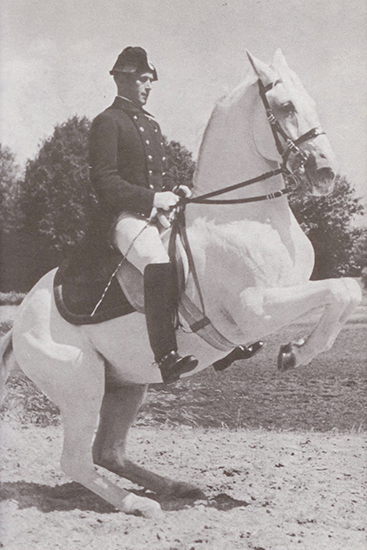
“If you read the rule book, the preamble says something along the lines that the FEI is here to uphold the art in the sport. And you think, where’s the art anymore? If all of these people hundreds of years ago were creating this art that we are now trying to mimic or keep alive, they were the ones who created the standard that works and has been proven…”
“It’s evolving in a way that’s almost out of control, based on how our rule book’s been written. If you read the rule book, the preamble says something along the lines that the FEI is here to uphold the art in the sport. And you think, where’s the art anymore? If all of these people hundreds of years ago were creating this art that we are now trying to mimic or keep alive, they were the ones who created the standard that works and has been proven. Now it’s just trending more and more towards saying it’s outdated or it doesn’t work, and that’s just because people don’t want to study and take the time and learn and follow the rules.”
Do you think the Spanish Riding School still upholds the tradition?
“The one thing I do look to them for, one thing that I do think gets overlooked and that is all the piaffe / passage these days with the horses that don’t sit. A lot of competition horses are so far out with the hind legs in passage, that the riders get lower and lower to the ground as the neck gets higher and the croup gets higher and the rider is sitting in the middle on a bouncy trampoline. Then in piaffe, it’s as if the horses hit a mud bog or something, shuffle for a few strides or they’re trotting in place with no lowering of the croup. I’ve never seen Parzival piaffe where the front hoof is higher than the hind hoof. If judges and trainers had to pass basic physics classes before they were allowed to judge or train, it would really change the pool of people, because if you see a horse where the hind hoof lifts higher than the hind fetlock, where it actually starts to go higher or equal to the front hoof, then you can’t tell me that horse is loading on the hind legs. Thirty years ago, if you said, ‘I train passage before piaffe’, the dressage mafia would kill you, you’d be considered insane and that you didn’t know what you’re doing, which is true. You can’t teach a horse, once it has learned to open its pelvis and push its hind legs out and trampoline its back, to load its quarters. It’s almost an impossibility.”
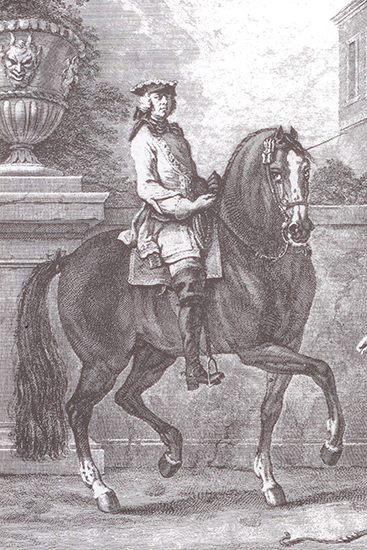
“The biggest thing with the Spanish Riding School is keeping the idea of airs above the ground alive because it shows why piaffe is here. It’s used to generate the levade, which is where the rest of the airs come from…”
“The biggest thing with the Spanish Riding School, is keeping the idea of airs above the ground alive, because it shows why piaffe is here. It’s used to generate the levade, which is where the rest of the airs come from. If you look the piaffes these days, there is only a handful where you would think, ‘That horse could levade.’ One of the last, big, amazing ones was Matador, Kyra Kyrklund’s horse where you just thought, ‘Wow’. You could imagine it could just levitate from that piaffe. Max, her other horse, kind of sat like that as well. It’s few and far between these days.”
“Everywhere you go today, you see five-year-olds where people say, ‘Oh it shows piaffe, passage talent,’ and they’re passaging around with a hollow back, legs everywhere and in slow motion. That’s not piaffe / passage talent. It’s impressive, but it doesn’t have anything to do with what we’re trying to do – which is load the hind legs. Everywhere you go, people have these horses ‘passaging’ who have no concept of what piaffe steps are. They’re trying to train it from the passage and it’s never going to happen.”
“I saw something the other day on some young horses with big, extended canters and the moments they’re catching on film where both hind legs are on the ground, and both front legs are still in the air and the comment was something like, “Look at these horses with these amazing canters.” But it’s not that amazing then. It’s telling you that the inside hind leg isn’t engaging far enough under. It’s telling you that the body is too artificially in the wrong posture if that’s being encouraged.”
“It’s not that you’re never going to get a bad moment. It’s not about saying those moments don’t happen but to accept them as the norm and overlook of the fact that it’s going on, instead of saying, ‘This isn’t right,’ is just bizarre.”
Jeremy is committed to holding up dressage based on classical principles and is not shy on calling those out who stray. He is very clear about what is required from each horse and rider and the best progressions to get there. His ideas are based on decades of study, both in theory and in the arena. Long may he and others like him work to keep the dressage honest!
Thank you Rebecca for this great interview!
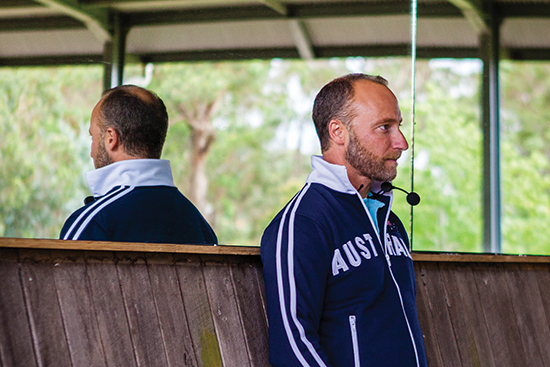
This article first appeared in the February 2016 issue of THM.


this man says it how it should be said, pity the “groupies” don’t listen, and the ones who stand alone just don’t bother any more with competing as the judging is like all sport judging now it seems and appears rather :”set up. “
A gorgeous overview about how dressage should be. If you live in Australia and want to learn the correct way to ride your horse, check out Belinda Bolsenbroek – she works from the same page as Jeremy and is a GIFT for Australian riders http://belindabolsenbroek.com/studfarm.html. Well done to all of the riders who enjoy connecting with their horse through ‘feel’ instead of force. The journey is longer, but the reward is worth it. Enjoy your horse, Peta
Great read…….very interesting article. Jeremy you are a breath of fresh air……hopefully people will take on board what you are saying.
Want to ride correct dressage, simple as adhering to the rules and directives.
Directive regarding pulling back
So FEI judges have a guidelines book for judging and here is a line from page 10 regarding differentiating causes of contact problems:
“Broken arch in the neck. This occurs as a result of the rider attempting to establish contact by using the hands in a backward direction. The highest point is no longer the poll but a point further back, usually between the and second and third vertebrae.”
What does this say about the judging? The broken neck has become the accepted standard.
If a rider is pulling backward the rider is applying the brakes. There is absolutely no other available action and thus is giving the horse different aids of forward and braking. As such each and every gait could not be pure by any sense of the word, nor could the horse be balanced.
I know there are many other directives, however, this particular one should have the most influence upon all the other directives. Why? Simply that one of the prime directives state that the horse – ‘appear to be doing it on its own’ – CANNOT be met what so ever. Therefore, all aspects of the movements and gaits of the test cannot be achieved to any degree of high standards and the scores should reflect that, i.e. being in the range of 60’s maximum and that is for GP.
Correct means correct. The rules and the directives stipulate what is correct and therefore must be met. Anything less is a disgraceful act against the purity of dressage in the competitive arena.
I knew Jeremy in Washington in the nineties. Very talented rider. Nice to read this interview, and agree with him.
What a fabulous article! I so enjoyed it! I think I’ll be rereading it again and again! A very knowledgeable gentleman who adheres to the principles of classical dressage and calls out the trends that don’t fit within these guidelines! If he is ever running a clinic in Victoria, Australia, that’s one I want to watch!
Great article! Bang on truth. Now hoping to meet Jeremy during my own travels.
Very great instructor and very good read! If only all trainers would go back to classical methods. How our horses would benefit! I will continue to train classical because I owe it to my horses! I totally agree with him and respect his speaking out! Sheila M Buschette
Oh thank you, Jeremy. Such a relief to know that someone out there in dressage land is not afraid to speak the truth! I am appalled to see some of the fake stuff being awarded good scores. We should not be striving to produce circus acts. If the judges don’t hold us all accountable for training for correctness and excellence, who will?
Thanks Jeremy. This was a good article!
Occasionally I read an article such as this, & I become excited . But after judging, I become disillusioned, once again & know that most probably nothing will change.
What Jeremy has said is true for me, & he has critiqued the horses so well.
Thank you.
Hurrah Jeremy for being brave and saying it like it is! You are making Dietrich and Kim proud. Thank-you!
Hallo Jeremy,laß Dich nicht verbiegen . Du hast recht! Da sind immer ein paar ,Die das genauso sehen.
What a great interview! Dressage needs people like Jeremy! Dressage also needs people like those at “The Horse Magazine ” who are prepared to print these interviews. It is easier for them to just go with the flow following the current trends just like trainers,coaches and riders. Thank You.
Thank you lord, there’s another good guy out there! Good to know and good to see!
So well written…
Charles DeKunffy says that dressage should first be therapeutic and restorative (returning the horse to its natural potential of movement) and then it should enhance the gaits. We have lost the emphasis on purity of gait (rhythm) and activity. Riders need to take the time to ride correctly, find their seat. This takes a lot of time on the lunge line and time without stirrups. The horse is the clock. You can’t go any faster than the horse can handle emotionally and physically! Right on Jeremy!
Thank you for this wonderful article, it’s a breath of fresh air that is much needed!
Thank you Jeremy for saying so clearly what has been on my mind for years!
You truly have snatched the pebble…. So proud of you!
I’ve known you a long time, Jeremy. You are an honest man and one I am proud to call my friend. I agree with you about what has happened to dressage and I fear there is no way back from this dark side. I would love to be a fly on the wall when the Chef’s and coaches get together and talk about this…
But, by far, my favorite part of this article was when you said you didn’t know what a huge influence Dietrich would have on you. I hear him in your words and know he is smiling and laughing and watching over you from heaven, with a hot cup of coffee in his thermos, of course.
Cheers to you on a job well done!
For those who want to compete, why not create a new format? Start over! I have not interest in competing, but would enjoy an opportunity to see video of relaxed, highly trained horses with balanced, kind riders gathered in one venue. If FEI can not be changed, build something better.
Jeremy, you should look into the Cowboy Dressage world, and the “soft feel” philosophy of Eitan Beth-Halachmy. I think you would agree with his kind approach. It’s all about the relationship between horse and rider. No forcing performance.
If one always has a smiie and loves what they are experiencing with the horse, chances are it is relaxed and happy.
There’s a market for a breath of fresh air, too, it appears.
LOL.
And there’s also a danger.
BRAVO!!! So refreshing to hear and see someone take a stand on what’s wrong with our sport.
A really thought provoking article from a brave and knowlegeable man. Thank you
Daring to go against the grain. But I couldn’t agree more!
I would love to get to know him!
Jeremy, you should get to know Hans Biss from Hamburg Germany, he is one of the last of the old masters and strictly adheres to classical teachings. He has an incredible eye for balance. At 80 years old he is still in the saddle and teaching and training. Many years ago Franz Rochowansky commented that Hans was the only German he would allow on a horse of his.
Brilliant!
Thank you for speaking up for the horses.
I read all the books I could find to try and understand more.
Please keep speaking out about this. I have seen what the Olympics has done
to the art of dressage. A horse could not be strong enough until it’s teens to do movement correctly.
Now if they are not performing at a high level by the time they are 6 yo they go to the plate.
What a shame. When money is involved horses lose.
Thank you so much for publishing this interview, Chris. When judging, seeing the incorrect horse, marking accordingly, it is so disappointing to find at the end of the day that you are way out with your co-judges because they loved his passagey trot, or his pretty round neck – even at novice level.
It seems our judges are being taught all the wrong things and I agree so much with Jeremy that the judges should never be the ones to dictate the way the “sport” is heading because right now we’re not doing much of a job.
Jeremy, have you been listening to my rants and rages? I totally agree with you and I am surprised a relatively young person is also frustrated with the Modern Dressage training. I do not know if our awareness of the decline of Dressage as an art form will change anything but it helps to know one is not alone. We are not the majority but the minority. I think the average person does not utilize the opportunity to watch a high standard of competition. Anyone can watch top competitions on Clipmyhorse.tv. and improve their eye. Thank you for having the courage to “go out on a limb”. I believe it will be productive.
Excellent!
So glad to read this. Gerd Heuschmann gives the mechanics well. Perhaps what is needed right now is a new, separate association of those who follow classical principles and judge accordingly, because what’s the point of showing now?
These are great points! However, I judge a person by what s/he does vs. what s/he says. We can say all of the right things or say it “like it is”, but none of it matters if the words aren’t lived. For those of us who have seen and been part of this rider’s/trainer’s world, his actions do not yet match his words. When his actions match his words, he will carry more credibility and weight in the world in which he wants to thrive.
So Proud Of You Jeremy!
Frigging awesome,
It’s good to see Jeremy succeeding, I shod his horse years ago when he won the Young Riders Nationals and just started training at North Star farms. We spent many hours in the tack room eating bagels and drinking coffee,good times.
Once I used to love to watch dressage and with the passion of my youth, I even aspired to be a dressage rider. I studied all the old masters books, went to all the good instructors that ever came by, and loved everything about dressage – then I got older and had my kids and stopped riding myself for a bunch of years, but taught my kids to ride instead… they then chose showjumping over dressage. Now I watch dressage of today and suddenly, sadly I just cant bear it. I dont really understand what exactly has changed, but I just cant bear to watch it… So many serious grim faced people torturing horses – making their horses like dumb robots with mechanical movement that has absolutely no joy – maybe they call some of this movement extravagant – but to me it all looks artifical and ugly…. cant bear to watch it…. Just my opinion, not trying to start world war 3. yes I agree drop it from the Olympics. Its become ridiculous in there, Maybe all the horse sports should be dropped. Sad but true. The world has moved on from the time when men went to war on horses.
Had my 14 year old twins read this. It takes the pressure off for them and let’s them into a more sane and loving world of dressage, to help them understand that dressage is an art, and a process of learning. Jeremy reminds us of this saying I’ve taught my girls; ” competitive men compete to beat somebody, an artistic man competes solely for the accomplishment”.
Yes !!!! Excellent !! what has happened to first of all allowing horses to mature so they are strong enough for the work everyone is in such a rush. I too can’t find anybody to work with since Dietrich’s passing. I still hear his voice when I’m riding
I got a lesson from Jeremy in 2003 or 2004 in humboldt co ca and also watched him teach many times when i worked as an assistant trainer at lazy l ranch. I loved to watch him and hear his techniques he is a motovational instructor with loads of tallent. I wish i could ride with him again as the tallent as far as riding instructors have all moved south. I rode under carrie harnden as a rideing instructor for years as a youth and then became employed by her husband. Though i didnt agree with his specific training style or lack of. I tryed to take my way to the dressage erina where carrie instructed. I loved her passion and analogues that alwayse made complete sence and drove my passion as a rider to grow more and more. Much like jeremy tought me. I hope to ride with him again soon and glad to see he’s doing so well. Any dollar spent on clinicing with him is a good dollar spent as far as im concerned. Thanks again for your passion and knoledge. Your friend Layne Nichols. P.S. thanks again for the info on the equestrian aid foundation info im still getting a monthly grant from them and appreciate you telling me about them currently my health is good and im still riding on
When Jeremy came to Christchurch I thought Hallelujah at last someone who says it how it is he saw through the poor basics the incorrect rhythm and the forced training methods. He tried hard to get everyone to see but hey what can a man do in a couple of hours with a motley crew of horses that we could see had training issues.
I am sad he has not been appreciated here in New Zealand a country who teaches itself and has very little knowledge and discipline. I am old now but have been in New Zealand for 44 years and watched dressage develop and become the shallow modern disaster we see today. The poor horses retired very young and unable to develop.
So much waste but partly because of training issues from the very early days of the horses training. I could go on and on but who am I, I never got past level 3! But even an amateur can watch figure skating and see the faults or the well-trained skills.